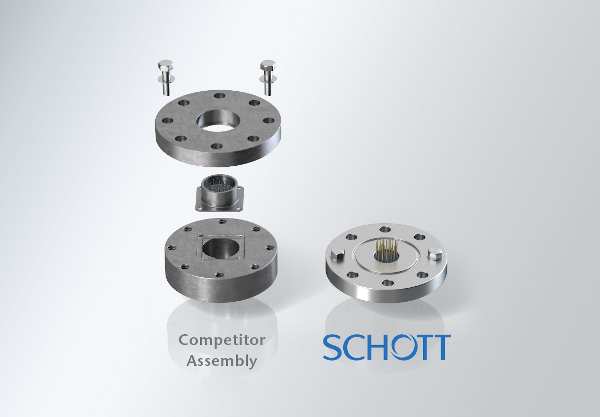Technical Details of Eternaloc®
Eternaloc® feedthroughs can be designed to…
SCHOTT Eternaloc® Terminal Headers for Liquefied Gas Applications
Gas pressure and extreme temperatures as low as -165°C place incredibly high demands on pumps and other equipment in liquefied gas applications. The requirements are equally high for their electrical terminal header assemblies, particularly since the safety consequences of terminal header failure or leakage can be severe. Thanks to unique compression glass-to-metal sealing technology, Eternaloc® electrical terminal headers are extremely robust, compression-sealed units that provide practically unlimited pressure-proof hermeticity and enhanced safety in cases of accidents. Decades of maintenance-free reliability helps reduce total cost of ownership.
In contrast, other sealing technologies that use organic polymers or ceramics have technical disadvantages that can compromise the integrity of the seal and result in leakage and electrical malfunction, especially when exposed to severe temperature fluctuations over time.
| Eternaloc® Terminal Headers for Liquefied Gas Applications | Technical Features |
|---|---|
| Lifetime | Unlimited lifetime of the non-aging pressure barrier |
| Temperature resistance | Resistant to thermo-shocks, thermo-cycling, and temperature ranges
from -196 °C to + 100 °C or -321 °F to +212 °F |
| Pressure resistance | Each product is tested at one-and-a-half times the maximum design pressure,
up to 390 bar |
| Electrical rating | Medium voltage, low voltage, C&I, and fiber optic penetrations |
| Options | Available with
|
| Dimensions | Fully customizable up to a diameter of 600mm |
| Quality assurance |
|
| Installation |
|
| Certifications |
SCHOTT Eternaloc® feedthroughs are certified according to ATEX and IECEx and fulfill the requirements of KOSHA, PESO, CU TR, UL, CSA. |
SCHOTT Eternaloc® Nuclear Electrical Penetration Assemblies
High-quality, hermetically sealed Eternaloc® electrical penetration assemblies (EPAs) from SCHOTT have the capability to deliver the dual benefit of increased safety and reduced total cost of ownership in nuclear power plants.
By utilizing inorganic, non-aging glass seals with significant heat- and radiation-resistant properties, SCHOTT EPAs provide considerable advantages. In contrast, epoxy seals may break down under extreme temperature and pressure. This was observed at the Fukushima Daiichi nuclear power plant disaster in 2011, among other instances.
| Eternaloc® Nuclear Electrical Penetration Assemblies | Technical Features |
|---|---|
| Degree of protection |
|
| Lifetime |
|
| Temperature resistance | ≥ 400 °C / 8h (752 degrees Fahrenheit) |
| Pressure resistance | ≥ 400 bar (5800 psi) |
| Radiation dose | 0.5 x 10^6 G |
| Electrical rating | Power, low voltage power, C&I, coax / triax and fiber optic penetrations |
| Customization options |
Eternaloc® penetration modules for nuclear power plants can be custom-designed with:
|
| Dimensions | 2,5" and 4" standard EPA's, custom designs up to 600mm and 250 kg |
| Quality assurance |
|
| Certifications | We are certified according to internationally recognized standards, including ISO 9001, ISO 14001 and KTA 1401. Additionally, our products comply with ATEX and IECEx requirements and can be manufactured in compliance with ASME NPT and MO, NQA-1 and HAF604 standards. |
SCHOTT Eternaloc® Compressed Gas Lead-through Plates
To design Eternaloc® lead-through plates for hydrogen gas-cooled generators and other compressed gas applications, SCHOTT utilizes only inorganic and non-aging materials: the feedthroughs consist of a steel flange with the conductors or thermocouples sealed in using compression glass-to-metal sealing technology. The specialty glass acts as the electrical insulator and hermetic seal, which reliably prevents leakage of hydrogen, as well as intrusion of oxygen or moisture.
In contrast, lead-through plates that use organic, naturally aging epoxy seals could compromise the generator’s pressure integrity, resulting in leakage and electrical malfunction.
| Eternaloc® Compressed Gas Lead-through Plates | Technical Features | Your Benefit |
|---|---|---|
| Conductors |
For power supply, signal transmission, and measurements, such as:
(RTD= Resistance Temperature Detector, Thermocouple)
Available in standard and customized designs |
Manufactured according to your requirements, no limitations regarding the type of signal
|
| Pressure resistance | Withstand high pressure up to 2700 bar | Maintain pressure boundary integrity of generator |
| Leak-tightness | Gas-tight hermeticity is usually tested to pass 10-8 mbar l/s leaking rates, which prevent leakage of hydrogen and intrusion of media into the generator. |
|
| Electrical rating |
|
Technological variety enables you to equip the whole generator with glass-to-metal sealed feedthroughs |
| Quality assurance | 100% final inspection of all products | Minimizes your efforts for incoming inspection |
| Installation |
|
Reduces the final weight and bulkiness of generator |
| Lifetime |
|
Contributes to longevity and lower cost of ownership of the generator |
| Certifications | SCHOTT Eternaloc® feedthroughs are certified according to ATEX and IECEx and fulfill the requirements of KOSHA, PESO, CU TR, UL, CSA. | Customers receive locally and internationally certified products and benefit from SCHOTT's long-term certification experience. |
SCHOTT Eternaloc® Oil and Gas Connectors, Feedthroughs and Penetrators
Subsea: Years of maintenance-free robustness above 20,000 PSI
Eternaloc® subsea connectors and feedthroughs offer long-term durable protection of subsea tree components, such as wellhead pressure sensors, in high temperature, high pressure (HPHT) conditions. Eternaloc® connectors are available as a complete subsea connector assembly for your application for greater safety, simpler testing and qualification, and space-saving purposes.
Exploration: Made to withstand 35,000 PSI and above
Made with inorganic, non-aging, and ultra-robust glass seals, Eternaloc® exploration connectors are designed to support safe and reliable transmission of valuable data and information provided by sensors in HPHT Wireline, MWD and LWD oil and gas applications. The extreme conditions in drilling applications are prohibitive for lesser-quality materials. For example, connectors using thermoplastic seals are prone to deformation from creepage, leading to an increased risk of seal compromise and component damage.
| Eterenaloc® Oil & Gas Feedthroughs | Subsea Connectors | Exploration Connectors | ||||||
|---|---|---|---|---|---|---|---|---|
| Temperature resistance | For ranges from -170°C to +450°C (-274°F to +842°F) | For temperatures in excess of 260°C (500°F) | ||||||
| Pressure resistance |
Years of maintenance-free robustness above 20,000 PSI
|
Ultimate pressure resistance - above 35,000 PSI
|
||||||
| Electrical performance | Electrical performance up to 13,800 V, 1500 A |
Superior insulation resistance under extreme conditions: ≥10GΩ - with our high-temperature sealing glasses, higher IR can be achieved at 260°C in some circumstances. |
||||||
| Dimensions | Dimensions up to 600 mm diameter, 500 mm height, and 250 kg weight. | |||||||
| Lifetime |
|
|||||||
| Customized options |
Fully customizable
|
Fully customizable
|
||||||
Material options
| Metals | Glass | Ceramic |
|---|---|---|
|
Sealing Alloys
|
Sealing Glasses
|
|
Steel
|
Optical Materials
|
|
|
Alloy 625 / 690 |
Additional Insulating Materials
|
Simplifying your processes with less welds
Eternaloc® connectors are available as a complete subsea connector assembly for your application for greater safety, simpler testing and qualification, and space-saving efforts.

SCHOTT Eternaloc® Submarine Penetration Assemblies
Reactor integration in submarines requires careful engineering and specialized components. Bulkheads fortified with radiation shields separate the reactor from the rest of the submarine. Electrical pass-through is required into and out of the reactor area for power, instrumentation, and control cables.
In standard applications, polymers or epoxies can be used to surround and insulate the cables at the pass-through point. But in nuclear applications, where the barrier must remain hermetic for safety and radiation protection, this sealing is insufficient. Here, glass-sealed SCHOTT Eternaloc® bulkhead penetrations deliver resistance to extreme shock, pressure, vibration, and temperature – in some cases as much as 50 times greater than typical submarine component requirements.
| Eternaloc® Submarine Penetration Assemblies | Technical Features |
|---|---|
| Lifetime |
|
| Temperature resistance |
|
| Pressure resistance |
|
| Electrical rating |
Power, C&I and fiber optic penetrations including matching connectors designed to customer requirements
|
| Quality assurance & testing |
SCHOTT electrical penetration assemblies for ships and submarines are manufactured according to the highest quality standards combined with leading engineering know-how and undergo vigorous tests to meet advanced systems specifications:
|
